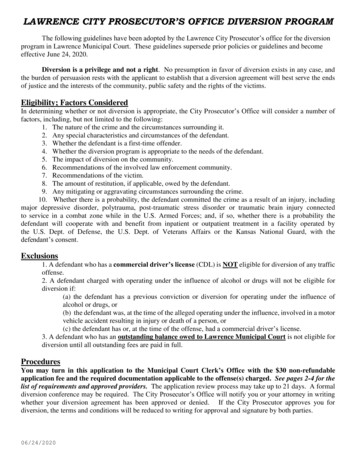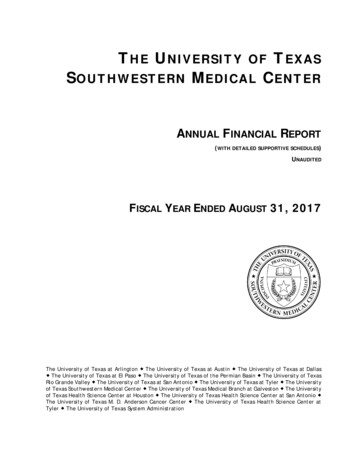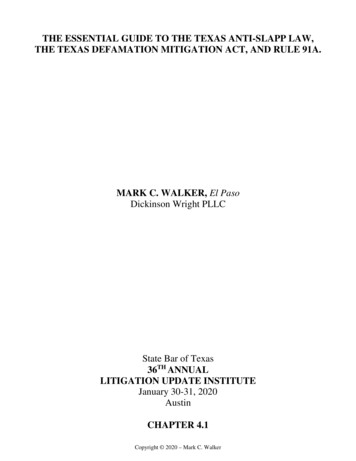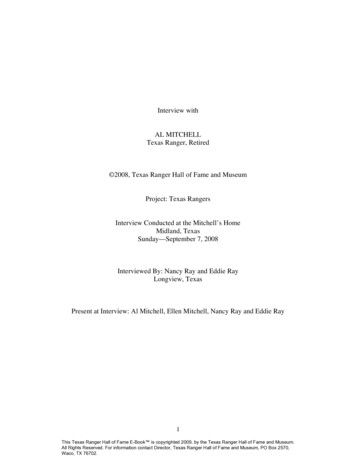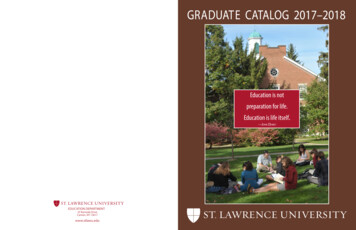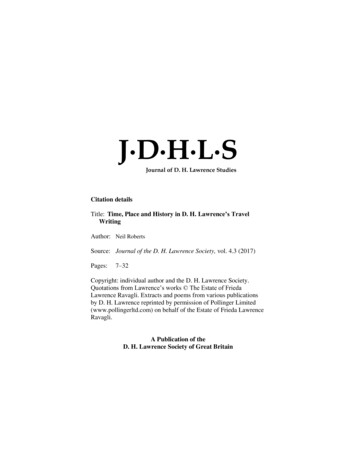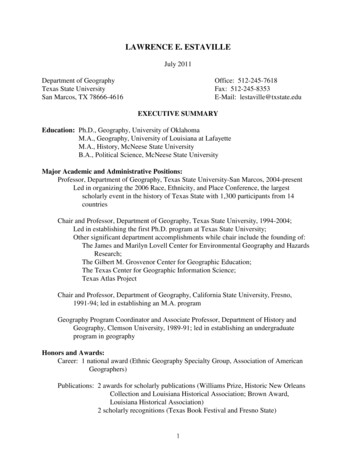
Transcription
LAWRENCE E. ESTAVILLEJuly 2011Department of GeographyTexas State UniversitySan Marcos, TX 78666-4616Office: 512-245-7618Fax: 512-245-8353E-Mail: lestaville@txstate.eduEXECUTIVE SUMMARYEducation: Ph.D., Geography, University of OklahomaM.A., Geography, University of Louisiana at LafayetteM.A., History, McNeese State UniversityB.A., Political Science, McNeese State UniversityMajor Academic and Administrative Positions:Professor, Department of Geography, Texas State University-San Marcos, 2004-presentLed in organizing the 2006 Race, Ethnicity, and Place Conference, the largestscholarly event in the history of Texas State with 1,300 participants from 14countriesChair and Professor, Department of Geography, Texas State University, 1994-2004;Led in establishing the first Ph.D. program at Texas State University;Other significant department accomplishments while chair include the founding of:The James and Marilyn Lovell Center for Environmental Geography and HazardsResearch;The Gilbert M. Grosvenor Center for Geographic Education;The Texas Center for Geographic Information Science;Texas Atlas ProjectChair and Professor, Department of Geography, California State University, Fresno,1991-94; led in establishing an M.A. programGeography Program Coordinator and Associate Professor, Department of History andGeography, Clemson University, 1989-91; led in establishing an undergraduateprogram in geographyHonors and Awards:Career: 1 national award (Ethnic Geography Specialty Group, Association of AmericanGeographers)Publications: 2 awards for scholarly publications (Williams Prize, Historic New OrleansCollection and Louisiana Historical Association; Brown Award,Louisiana Historical Association)2 scholarly recognitions (Texas Book Festival and Fresno State)1
Teaching: 1 national award (National Council for Geographic Education)1 university award (University of Wisconsin-Oshkosh)4 university recognitions (Clemson and Fresno State)Leadership: 2 university awards (Texas State)3 department awards (Texas State and Fresno State)Service: 2 national awards (Ethnic Geography Specialty Group; Business GeographySpecialty Group, Association of American Geographers)1 university award (Texas State)Community Leadership/Service for an Organization:1 national award (with others; National Marrow Donor Program)1 regional award (with others; South Texas Blood and Tissue Center)Honor Societies:Sigma Xi Scientific Research SocietyHonor Society of Phi Kappa PhiOmicron Delta Kappa National Leadership Honor SocietyPhi Beta Delta Honor Society for International ScholarsGamma Theta Upsilon International Geographical Honor SocietyPhi Alpha Theta International Honor Society in HistoryMilitary: Eleven decorations including the Army Meritorious Service Medal and the ArmyCommendation Medal with Oak Leaf ClusterCommander, Superior Unit AwardPublications:6 books (one honored with the Williams Prize, one featured at the Texas BookFestival, one published by the Johns Hopkins University Press)1 book in press for publication in 2011: Texas Health Atlas (Texas A&M UniversityPress)3 co-editorships for national journal special issues31 peer-reviewed journal articles (one honored with the Brown Award, onepublished by Cambridge University Press, 10 invited)10 peer-reviewed book chapters (one published by the Oxford University Press; 7 invited)3 encyclopedia articles (1 forthcoming); 2 map series; 4 book reviewsScholarly Presentations: 21 invited papers, 73 conference papersTotal Grants and Contracts Awarded: 5,781,775Largest single grant: 1 million, Houston EndowmentLargest multi-year contract (with co-PIs): 2,380,000, Texas Commission onEnvironmental Quality2
Teaching: Taught 15 graduate, 3 undergraduate-graduate, and 20 undergraduate courses;proposed and developed 6 graduate, 3 undergraduate-graduate, and 8undergraduate coursesResearch advisor for 3 Ph.D. students and 10 master's studentsService: Led in establishing the Texas State Cancer Advocacy Movement for Colleges andOutreach (originally Texas State Cancer Awareness Month and CommunityOutreach)Led in establishing the Ethnic Geography Specialty Group, Association of AmericanGeographersLed in establishing the Business Geography Specialty Group, Association of AmericanGeographersVice President, California Geographical SocietyVice President, Wisconsin Council for Geographic EducationCo-Director and Board Member, International Race, Ethnicity, and Place ConferencesMember, Association of American Geographers Diversity TaskforceMember, Cancer Alliance of TexasMilitary: Lieutenant Colonel, United States Army/Army Reserve, RetiredGraduate of the U.S. Army Command and General Staff CollegeFinal Tour of Duty: The Pentagon, Washington, DC3
LAWRENCE E. ESTAVILLEJuly 2011EDUCATIONGRADUATEPh.D., Geography, 1984University of Oklahoma, Advisor: Richard L. NostrandSpecializations: Ethnic, Historical, American South, MethodologyDissertation: The Louisiana French culture region: Geographic morphologies inthe nineteenth century, 2 vols. (Association of American Geographers NystromAward finalist)M.A., Geography, 1974University of Louisiana, Lafayette, Advisor: E. F. StallingsSpecializations: Cultural, Louisiana, Water ResourcesThesis: A regional geography of Calcasieu Parish, Louisiana: The culturalperspectiveM.A., History, 1970McNeese State University, Advisor: Joe Gray TaylorSpecializations: Louisiana, Jeffersonian-Jacksonian Democracy, NineteenthCentury EuropeThesis: Louisiana railroads in the Civil WarUNDERGRADUATEB.A., Political Science, 1968McNeese State UniversityUNIVERSITY POSITIONSProfessor of Geography, Department of Geography, Texas State University, April 2004 presentChair and Professor of Geography, Department of Geography, Texas State University, July1994 - April 2004 (Tenured)Chair and Professor of Geography, Department of Geography, California State University,Fresno, August 1991 - August 1995 (Tenured)4
UNIVERSITY POSITIONS continuedGeography Program Coordinator and Associate Professor of Geography, Department ofHistory and Geography, Clemson University, August 1989 - August 1991 (Tenured)Assistant Professor of Geography, Department of History and Geography, ClemsonUniversity, August 1987 - July 1989Assistant Department Head and Associate Professor of Military Science, Department ofMilitary Science, University of Wisconsin-Stevens Point, August 1986 - July 1987Visiting Assistant Professor of Geography, Department of History, Clemson University,August 1985 - July 1986Lecturer in Geography, Department of Geography and Urban Studies, University ofWisconsin-Oshkosh, September 1980 - July 1985Co-principal Investigator with Richard L. Nostrand, National Science Foundation ResearchProject, Department of Geography, University of Oklahoma, January - December1980Instructor/Teaching Research Associate, Department of Geography, University ofOklahoma, June 1978 - December 1979Assistant Professor of Geography, Department of Social Sciences, McNeese StateUniversity, January 1971 - August 1978 (Tenured)Graduate Teaching Assistant, Department of Social Sciences, McNeese State University,August 1968 - May 1970AWARDS AND HONORSCAREERDistinguished Ethnic Geographer Career Award, Ethnic Geography SpecialtyGroup, Association of American Geographers, April 2010(highest honor for an ethnic geographer in North America)PUBLICATIONS AND RESEARCHL. Kemper Williams Prize for the best scholarly book about Louisiana historypublished in 1989, The Historic New Orleans Collection and the LouisianaHistorical Association5
AWARDS AND HONORS continuedRobert L. Brown Award for the outstanding article about Louisiana historypublished in 1973, Louisiana Historical AssociationEstaville, Lawrence E., and Richard A. Earl. Texas water atlas. College Station,TX: Texas A&M University Press. Honored as a featured book at the TexasBook Festival, one of the most renowned book festivals in the U.S., November2008.Recognition for Excellence in Research and Publication, School of Social Sciences,California State University, Fresno, November 1992, April 1994Warren Nystrom Award finalist for the outstanding geography dissertation in NorthAmerica completed in 1984, Association of American GeographersTEACHINGDistinguished Teaching Achievement Award, National Council for GeographicEducation, 1985Distinguished Teacher Award, University of Wisconsin-Oshkosh, 1983-84Master Teacher Award finalist, Clemson University, 1988-89, 1990-91Recognition for Excellence and Innovation in Teaching and Mentoring, School ofSocial Sciences, California State University, Fresno, April 1994Recognition for Excellence in Teaching Innovation, School of Social Sciences,California State University, Fresno, April 1993DISCIPLINARY SERVICEOutstanding Service Award, Business Geography Specialty Group, Association ofAmerican Geographers, April 2011Distinguished Service Award, Ethnic Geography Specialty Group, Association ofAmerican Geographers, March 2003UNIVERSITY LEADERSHIP AND SERVICEOutstanding Leadership Award, Department of Geography, Texas State University,April 2007Texas State Presidential Resolution for Outstanding Performance in Leading theOrganization and Implementation of the 2006 International Race, Ethnicity,6
AWARDS AND HONORS continuedand Place Conference, Texas State University, April 2007. The REP III was thelargest scholarly conference ever at Texas State with 1,300 registrants from 14countries.Outstanding Service and Exemplary Leadership Award for Ten Years of Excellenceas Chair and Professor of the Department of Geography, Associated StudentGovernment, Texas State University, May 2004Faculty Award for Outstanding Achievement in International Education for 2008,Texas State University, November 2008.Lawrence Estaville Geography Scholarship. Established in my honor by theDepartment of Geography, Texas State University, for ten-year leadership of thedepartment, April 2004Graduate Commencement Speaker, Southwest Texas State University, 22 December2000Outstanding Leadership Award, Alumni Reunion Committee, Department ofGeography, Southwest Texas State University, April 1997Invited Founding Member, Pacific Rim Studies Center, California State University,Fresno, October 1992 - August 1994Outstanding Leadership Award, Department of Geography Graduate Students,California State University, Fresno, April 1993COMMUNITY SERVICE AND LEADERSHIPCoordinator, Texas State Cancer Awareness Month and Community Outreach,National Marrow Donor Program's 2009 Collegiate Award (for a university)Coordinator, Texas State Cancer Awareness Month and Community Outreach,2009 South Texas Blood and Tissue Center Service Award (for anorganization)HONOR SOCIETIESSigma Xi Scientific Research Society, May 1982Honor Society of Phi Kappa Phi, September 1974Omicron Delta Kappa National Leadership Honor Society, November 19907
PUBLICATIONS AND RESEARCHGamma Theta Upsilon, International Geographical Honor Society, February 1992Phi Beta Delta, Honor Society for International Scholars, September 1993Phi Alpha Theta, International Honor Society in History, February 1977PUBLICATIONSPublication Summary: 6 books (one honored with the Williams Prize, one featured at theTexas Book Festival, one published by the Johns Hopkins University Press); 1 bookin press for publication in 2011: Texas Health Atlas (Texas A&M UniversityPress); 3 co-editorships for national journal special issues; 31 peer-reviewed journalarticles (one honored with the Brown Award, one published by CambridgeUniversity Press, 10 invited); 10 peer-reviewed book chapters (one published by theOxford University Press; 7 invited); 3 encyclopedia articles (1 forthcoming); 2 mapseries; 4 book reviewsBOOKSPeer-reviewed:2011 Estaville, Lawrence E., Kristine Egan, and Abel Galaviz. Texas health atlas.College Station, TX: Texas A&M University Press. In press. Eight chapters thatfeature 350 color maps, almost all original cartography, highlighting vitalaspects of the health wellbeing of Texans. Includes a Texas Medical Timelinethat tracks notable medical advancements.2010 Estaville, Lawrence E., ed., Geography undergraduate programs: Pathways tosuccess. Washington, DC: National Council for Geographic Education,Pathways in Geography Series. Online: e%20Programs%20Revised%20Final%2012Jan11.pdf.Nine chapters explore student recruitment, retention, and placement; programmanagement and assessment; ethnic diversity; and active learning. The book'sgoals are to (1) construct explanatory models, (2) offer example surveyinstruments for gathering data for planning and assessment, and (3) suggestsuccessful strategies for enhancing programs.2008 Estaville, Lawrence E. and Richard A. Earl. Texas water atlas. College Station, TX:Texas A&M University Press. The first endeavor of its kind has seven chaptersthat feature 172 color maps and graphics highlighting the state's climate, waterresources and hazards, and projections for future water needs. Honored as afeatured book at the Texas Book Festival, one of the most renowned bookexpositions in the U.S., in November.8
2001 Nostrand, Richard L. and Lawrence E. Estaville, contributing co-editors.Homelands: A geography of culture and place across America. Baltimore:Johns Hopkins University Press and the Center for American Places. Sixteenpapers explore "homelands," in juxtaposition to Frederick Jackson Turner's"freeland" and Walter Prescott Webb's "dryland" theses, as a conceptual vehiclein trying to explain the settling of the United States.1997 Estaville, Lawrence E. and Carol Rosen, contributing co-editors. TeachingAmerican ethnic geography, in Pathways in Geography. National Council forGeographic Education: Indiana, PA. Eighteen papers share innovativeapproaches in teaching American ethnic geography to students in universitiesand high schools.1989 Estaville, Lawrence E. Confederate neckties: Louisiana railroads in the Civil War.Ruston, LA: McGinty Publications, Louisiana Tech University. A revisionistwork that focuses on the significance of railroads to both Southern and Northernarmies in Civil War Louisiana. Railways, not steamboats, saved New Orleansfrom both naval bombardment and starvation. Awarded The Historic NewOrleans Collection's L. Kemper Williams Prize presented by the LouisianaHistorical Association as the best scholarly book about Louisiana historypublished in 1989.Commercial:2001 Estaville, Lawrence E., editor, and Byron D. Augustin, associate editor. Schoolatlas of Texas. Austin, TX: W. S. Benson and Company. This 48-page coloratlas of Texas is the first of its kind and is aimed at filling an importanteducational need for the state's schoolchildren.JOURNAL SPECIAL ISSUES2008 Estaville, Lawrence E. and Fenda A. Akiwumi, guest co-editors. Journal ofCultural Geography 107 no. 6, special issue on race, ethnicity, and place.Estaville, Lawrence E. and John W. Frazier, guest contributing co-editors. Journalof Geography November/December, special issue on teaching about race,ethnicity, and place.1993Nostrand, Richard L. and Lawrence E. Estaville, guest contributing co-editors.Journal of Cultural Geography 13 (Summer), special issue on American ethnichomelands. Eleven papers develop the homeland concept and its importance inthe understanding of the American cultural landscape.9
PUBLICATIONS AND RESEARCH continuedINVITED JOURNAL ARTICLES (peer-reviewed)2009 Estaville, L. E. 2009. Geospatial workforce trends in the United States,International Journal of Applied Geospatial Research 1(1): 57-66. A study thatreviews pertinent literature and U.S. Department of Labor datasets tocorroborate the general sense that the geospatial workforce in the U.S. willcontinue robust expansion well into the next decade.Montalvo, Edris J. and Lawrence E. Estaville. 2007 issue published in 2009. Thenew Latino landscape in the Texas Panhandle. Southwestern Geographer11:72-91. An examination of the changes in the cultural landscape caused bythe recent migration of Latinos into the Texas Panhandle; published by theSouthwestern Division of the Association of American Geographers.2008 Estaville, Lawrence E., Fenda A. Akiwumi, and Edris J. Montalvo. 2008. Ethnicdiversity in geography undergraduate programs. Special Issue on TeachingRace, Ethnicity, and Place, Journal of Geography 107 no. 6: 3-11. Lead article.Examines diversity, particularly regarding Hispanics and African Americans, ingeography undergraduate programs in the U.S. and offers insights in creatingmore diverse student bodies.2007 Estaville, Lawrence E. GIS and colleges of business: A curricular exploration.Journal of Real Estate Literature 15(3): 441-48. Explores whether colleges ofbusiness in institutions of higher education in the U.S. incorporate GIS coursesinto their curricula to ensure that graduates have a better comprehension ofspatial analysis in business endeavors; published by the American Real EstateSociety.2006 Estaville, Lawrence E., Lisa Keys-Mathews, Brock J. Brown, and William R.Strong. Educating business geographers. GeoSpatial Solutions (online, 8pages), May. ions/article/articleDetail.jsp? id 325930. An analysis of national trends inundergraduate and graduate curricula for business geography and proposededucational strategies; published in an online refereed journal that reports onapplications of geographic information science in business.1993 Nostrand, Richard L. and Lawrence E. Estaville. The homeland concept. Journal ofCultural Geography 13 (Summer): 1-4. Lead article about the fundamentaldefining criteria necessary for a geographic homeland to exist; published in aspecial issue on American Ethnic Homelands.10
PUBLICATIONS AND RESEARCH continuedEstaville, Lawrence E. The Louisiana-French homeland. Journal of CulturalGeography 13 (Summer): 31-45. A seven-stage developmental model thatoutlines the Louisiana French geographical experience through time in a specialissue on "American Ethnic Homelands."1988 Estaville, Lawrence E. Were the nineteenth-century Cajuns geographically isolated?Geoscience and Man 25: 85-95. A reinterpretation of a time-honored myth in avolume of papers on the American South from the Sixth InternationalConference of Historical Geographers; published at Louisiana State University.1982 Estaville, Lawrence E. Horizons of environmental ethics: A plea for teaching adeeper meaning. Bulletin, Wisconsin Council for Geographic Education (nowthe Wisconsin Geographer) (Spring): 1-12. Lead article about humanistic,ecologic, and theistic environmental ethics published in Wisconsin's geographyjournal.1978 Estaville, Lawrence E. Northern Louisiana's strategic railroad: The Vicksburg,Shreveport and Texas in the Civil War. Journal of the North LouisianaHistorical Association 9 (Fall): 177-92. Lead article about the most importantNorth Louisiana railroad and its role as a trans-Mississippi link in the Civil War.JOURNAL ARTICLES (peer-reviewed)2007 Estaville, Lawrence E., Sally Caldwell, Brock J. Brown. Water resources projects inthe Texas Rio Grande Valley: An assessment of collaboration. Papers of theApplied Geography Conferences 30: 390-94. Asks the question: To whatdegree have various government agencies and NGOs been successful with theircollaborative efforts in addressing water resources issues in the Texas RioGrande Valley?2006 Estaville, Lawrence E., Brock J. Brown, Sally Caldwell. Geography undergraduateprogram essentials: Recruitment. Journal of Geography 105 (January/February): 3-12. Lead article. The first paper in a three-article series focuses onrecruitment strategies within a conceptual model for recruitment, retention, andplacement of undergraduate students; in the foremost national journal ingeography education; published by the National Council for GeographicEducation.Estaville, Lawrence E., Brock J. Brown, Sally Caldwell. Geography undergraduateprogram essentials: Retention. Journal of Geography 105 (March/April): 4752. Lead article. The second paper in a three-article series focuses on retentionstrategies within a conceptual model for recruitment, retention, and placementof undergraduate students.11
PUBLICATIONS AND RESEARCH continuedEstaville, Lawrence E., Brock J. Brown, Sally Caldwell. Geography undergraduateprogram essentials: Placement. Journal of Geography 105 (May/June): 93-98.Lead article. The third paper in a three-article series focuses on placementstrategies within a conceptual model for recruitment, retention, and placementof undergraduate students.Estaville, Lawrence E., Brock J. Brown, Sally Caldwell. Geography undergraduateprogram management. Journal of Geography 105 (September/October): 198208. Discussion of salient issues dealing with the geography departmentprogram management.Estaville, Lawrence E., Brock J. Brown, Sally Caldwell. Geography undergraduateprogram assessment. Journal of Geography 105 (November/December): 23948. Details programmatic assessment of geography department2005Estaville, Lawrence E., Lisa Keys-Mathews, Brock J. Brown, William R. Strong.Business geography: Development of a curriculum model. Papers of theApplied Geography Conferences 28: 292-300. Analyzes undergraduateprograms across the nation regarding business geography curricula and proposesa fundamental business geography curriculum.2001 Boehm, Richard G. and Lawrence E. Estaville. A model for geography departmentrecruitment of minority students. Papers and Proceedings of the AppliedGeography Conferences 24: 316-21. A three-stage model that the NationalGeographic Society's Education Foundation has funded to help improverecruitment of minority students into university geography departments acrossthe nation.2000 Boehm, Richard G., Lawrence E. Estaville, and Wendy Bigler. Health of thediscipline indicators. Papers and Proceedings of the Applied GeographyConferences 23: 300-08. Data from a variety of variables show a seriousdichotomy in the "health" of geography departments in the U.S.1991 Estaville, Lawrence E. Organizing time in geography: Explanations and activitiesfor teachers. Journal of Geography 90 (November/December): 267-70. Adiagrammatic analysis for secondary and college teachers of the basic temporalstrategies in geography and class exercises for each.1990 Estaville, Lawrence E. The Louisiana French language in the nineteenth century.Southeastern Geographer 30 (November): 105-20. A study of the languagemaintenance of the Louisiana French in a period of overwhelming Anglointrusion in the leading geographical journal in the Southeast; published by theSoutheastern Division of the Association of American Geographers.12
PUBLICATIONS AND RESEARCH continuedEstaville, Lawrence E. The Louisiana French region: National-scale boundaries.Southern Studies 1 (New Series) (Spring): 60-64. An examination of the manycartographic errors in small-scale maps of the Louisiana French region in aninterdisciplinary Southern journal; published at the Southern Studies Institute.1988 Estaville, Lawrence E. The Louisiana French in 1900. Journal of HistoricalGeography 14 (October): 342-59. A statistical analysis of a mathematicallyderived gradational paradigm in an international journal that is the mostimportant in historical geography; published at Cambridge University, UK.Estaville, Lawrence E. Debate: A teaching strategy for geography. Journal ofGeography 87 (January-February): 2-4. Lead article; an explanation of asuccessful teaching technique.1987 Estaville, Lawrence E. Changeless Cajuns: Nineteenth-century reality or myth?Louisiana History 28 (Spring): 117-40. Lead article; a revisionist paper thatchallenges the Cajun mystique in a state journal that is the most important inLouisiana history; published at the Center for Louisiana Studies.1986 Estaville, Lawrence E. Mapping the Cajuns. Southern Studies 25 (Summer): 16371. A cartographic review of the geographical markers of the Cajuns;published at the Southern Studies Institute.Estaville, Lawrence E. Mapping the Louisiana French. Southeastern Geographer26 (November): 90-113. A cartographic review of geographical markers of theLouisiana French; published by the Southeastern Division of the Association ofAmerican Geographers.Estaville, Lawrence E. Civil War images of a Cajun landscape: Bayous Lafourcheand Terrebonne. Attakapas Gazette 21 (June): 64-68. A brief study ofperceptions of a past landscape; published at the Center for Louisiana Studies.1977 Estaville, Lawrence E. A small contribution: Louisiana's short rural railroads in theCivil War. Louisiana History 18 (Spring): 87-103. An examination of the CivilWar contributions and tribulations of the state's rural lines.1973 Estaville, Lawrence E. A strategic railroad: The New Orleans, Jackson and GreatNorthern in the Civil War. Louisiana History 14 (Spring): 117-36. Leadarticle; a revisionist paper that underscores the significance of railroads to NewOrleans in the Civil War; Robert L. Brown Award from the Louisiana HistoricalAssociation for the outstanding article on Louisiana history published in 1973.Reprinted in Louisiana Purchase Bicentennial Series in Louisiana History.Lafayette, LA: Center for Louisiana Studies, University of Louisiana-Lafayette,2003.13
PUBLICATIONS AND RESEARCH continuedJOURNAL ARTICLES (non-peered-reviewed)2008 Estaville, Lawrence E., and Fenda A. Akiwumi, guest co-editors. Introduction.Thematic Issue on Race, Ethnicity, and Place, Journal of Cultural Geography,25, no. 3: 221-22.Estaville, Lawrence E., and John W. Frazier, guest co-editors. Forward. SpecialIssue on Teaching Race, Ethnicity, and Place, Journal of Geography 107, no. 6:209-10.INVITED CHAPTERS (peer-reviewed)2009 Akiwumi, Fenda A. and Lawrence E. Estaville. Somalis in Maine. In The AfricanDiaspora in North America at the dawn of the 21st century, eds. John W.Frazier, Joe Darden, and Norah Henry, 249-62. Binghamton, NY: GlobalAcademic Publishing, Binghamton University. An exploration of the culturalgeography dimensions of the Somali migration to the United States, particularlyto Maine.2006 Estaville, Lawrence E., Edris J. Montalvo, and Brock Brown. Population change inthe Texas Panhandle and resultant Latino occupational structure, 1980-2004. InRace, ethnicity and place in a changing America, Chapter 19, pages 251-62,eds. John W. Frazier and Eugene L. Tetty-Fio. Binghamton, NY: GlobalAcademic Publishing, Binghamton University. An analysis of the occupationalstructure of the Texas Panhandle Plains as reflected in recent Anglo outmigration and Latino in-migration.2004 Estaville, Lawrence E., Susan W. Hardwick, James P. Allen, and Ines MiyaresAmerican ethnic geography: Development, contributions, and challenges. InGeography in America at the Dawn of the 21st Century, eds. Gary L. Gaile andCort J. Willmott, 586-99. New York: Association of American Geographersand Oxford University Press (the most important work in geography eachdecade in providing the current status of the discipline). The chapter highlightsthe significant studies in American Ethnic Geography in the 20th century,particularly new research in the 1990s.1997 Estaville, Lawrence E., Carol Rosen, and Richard G. Boehm. American ethnicgeography and the National Geography Standards. In Teaching American ethnicgeography, eds. Lawrence E. Estaville and Carol J. Rosen, 1-4. Indiana, PA:National Council for Geographic Education, Pathways in Geography series.The chapter explains the use and importance of the National GeographyStandards in teaching American Ethnic Geography.14
PUBLICATIONS AND RESEARCH continuedEstaville, Lawrence E. Defining ethnicity through surrogate selection: Thenineteenth-century Louisiana French. In Teaching American ethnic geography,eds. Lawrence E. Estaville and Carol Rosen, 5-9. Indiana, PA: NationalCouncil for Geographic Education, Pathways in Geography series. A briefpaper that uses the geographical experiences of the Louisiana French in thenineteenth century to explore the concept of ethnicity.Estaville, Lawrence E. Teaching American ethnic geography through popular film.In Teaching American ethnic geography, eds. Lawrence E. Estaville and CarolJ. Rosen, 127-31. Indiana, PA: National Council for Geographic EducationPathways in Geography series. A pedagogic work that explains somepossibilities and caveats of using popular film to teach about American ethnicgeography.1991 Estaville, Lawrence E. Organizing time in historical geography. In Historicalgeography: A methodological portrayal, ed. D. Brooks Green, 310-24. Savage,MD: Rowman & Littlefield. A diagrammatic analysis of the three basictemporal strategies and their integrative designs used in historical geography.CHAPTERS (peer-reviewed)2010 Estaville, Lawrence E., Edris J. Montalvo, Fenda A. Akiwumi, Waverly C. Ray, andNiem Tu Huyhn. 2010. Teaching geography undergraduate courses: Activelearning. In Geography undergraduate programs: Pathways to success, ed. L.E. Estaville. Washington, DC: National Council for Geographic Education,Pathways in Geography Series, online. Creation of models for Key ActiveLearning Linkages and Major Active Learning Flows and an analysis of theways the models can facilitate active learning in geography undergraduatecourses.2001 Nostrand, Richard L. and Lawrence E. Estaville. Free land, dry land, homeland. InHomelands: A geography of culture and place across America, eds. Richard L.Nostrand and Lawrence E. Estaville, xiii-xxiii, Baltimore, MD: Johns HopkinsUniversity Press. A discussion of three geographical theories as explanatoryvehicles for the settlement of the U.S. and an exploration of the homelandtheory.Estaville, Lawrence E. Nouvelle Acadie: The Cajun homeland. In Homelands: Ageography of culture and place across America, eds. Richard L. Nostrand andLawrence E. Estaville, 83-100, Baltimore, MD: Johns Hopkins University Press.A synoptic analysis of the building of the Cajun homeland in South Louisiana.15
PUBLICATIONS AND RESEARCH continuedENCYCLOPEDIA ARTICLES (peer reviewed)2
Texas State University Fax: 512-245-8353 San Marcos, TX 78666-4616 E-Mail: lestaville@txstate.edu EXECUTIVE SUMMARY Education: Ph.D., Geography, University of Oklahoma M.A., Geography, University of Louisiana at Lafayette M.A., History, McNeese State University B.A., Political Science, McNeese State University Major Academic and Administrative Positions: Professor, Department of Geography .



